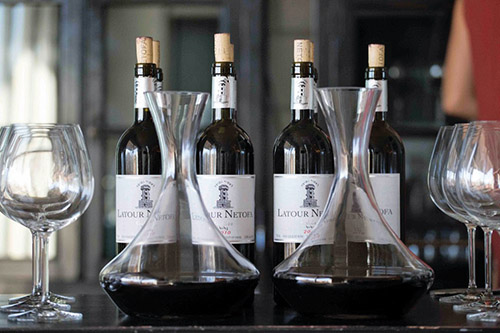



Netofa Winery, located in the Galilee in the foothills of Mount Tabor, is again being imported to the U.S. after a multi-year absence. Its availability has caused considerable excitement among the members of our wine tasting group, and not one of us left our tasting without a newfound joy in tasting wine and true gratitude for the wonderful opportunities being presented by Netofa.
The grape varietals that comprise Netofa wines offer experiences different and offbeat from your average Israeli cab or merlot. The sense at the table was that the Netofa experience offers “new fruits” perfect to celebrate around Rosh Hashanah. These primarily Loire, Rhone or Spanish region varietals, such as roussanne, mourvedre and tempranillo, are not typical grapes used for kosher wines, though they are becoming more common; they are pleasing to all palates, and we recommend every bottle in this article with our highest compliments. “From bottle to bottle, the attention to detail is just incredibly consistent,” said Michal. “It’s a credit to the winemaker’s process.”
“These are slightly more expensive, unusual blends; wines that offer opportunities to see what winemakers can do with their craft. These are better than your average wine, and something to splurge on to make Yom Tov special. I really think these are perfect to try out during the new year,” said Yeruchum.
Netofa’s winemaker, Pierre Miodownick, is one of the pioneers of the kosher wine industry, having made his first kosher wine, Château de Paraza, in 1982. After some discussion, our tasting group identified him as “one of the five most important people in kosher wine today.” He is originally French and was the first to make kosher runs of the most famous Bordeaux wines, including Château Giscours. He continued to make almost all the kosher runs of French wines for Royal Wines until 2014.
Miodownick works primarily with mediterranean grape varieties that complement the terroir in the vineyards, which he planted in 2006. On to the wines.
The Netofa Latour White 2017 is made with 100% chenin blanc, a variety originating from France’s Loire Valley, and aged in French oak barrels. This easy-drinking yet immensely structured wine is bright straw in color with aromas of fresh spring flowers, straw, tart strawberry and green apple. It is medium-bodied, with minerality; it has medium acidity, with hints of sweet melon and green apple on a long, lustrous finish.
The finish on the wine was one of the most special we’d experienced on a white wine in recent memory. The finish lingers intensely, in a good way. “This wine has a ‘tickles-the-tongue’ kind of acidity. A nice finish,” said Daphna.
“This wine has body and depth; it’s absolutely nothing like the Baron Herzog chenin blancs. This is more restrained, more balanced,” said Yeruchum. Right out of the gate, this was my favorite wine of the tasting.
The Netofa LaTour 2018 Rosato is made of 100% tempranillo, a Spanish grape most famous for red wines coming from Spain. This was a more fun wine, an easy-drinking wine to sip chilled on a warm afternoon. “It’s rare to have a Spanish-style rosé made from tempranillo. This is a great opportunity,” said Yeruchum, noting that he thought Miodownick also made a rosé for Ramon Cardova, a Spanish winery, in 2016. It turns out, actually, that wine was made by Miodownick’s successor,�Menahem Israelievitch.�
“It smells like watermelon candy,” mused Daphna. The color is relatively dark for a rosé, almost a light garnet. The aroma is light but complex, with a sense of sweet, dark fruit—maybe blackberries. It’s a medium-bodied wine that leans a touch towards the acidic but maintains a fruity palate. Its uniqueness lends itself to the more adventurous. Really fun.
The Netofa LaTour Red 2016 is a 70% syrah and 30% mourvedre blend. “Elegant, chocolatey, beautiful,” said Yeruchum. The deep purple color sent the group spinning into all kinds of descriptive references to coffee, chocolate, tobacco, “with some cherry or strawberry at midpalate,” added Daphna. A very lingering, nice finish,” she said.
Tel Qasser White 2017 is 100% roussanne, and a real treat. Truly the color of straw, there are notes of orange blossom, floral nose, very grassy, fresh and smooth. “I sense apple. This is so pleasant, but with much more body than a typical white,” said Bracha.
“A more complex wine, but sweeter than I expected,” said Daphna.
“More sophisticated than other whites,” said Greg.
The Tal Qassar Red 2017 is also a blend of 70% grenache and 30% syrah. It had aromas of red berries with some nice grassy tobacco and herbs, and dark cherry at the end. “A light, delicious red. The mouthfeel is different because grenache is a lighter grape,” said Greg.
The Netofa Dor 2016 is made from 100% tempranillo, and only 3,300 bottles were made of this special wine. The Dor is made only during vintages that the winemaker deems sufficient. The nose is strongly of cherry and cigar, with a thinner viscosity, very light bodied and very dry. “The nose is funky, not in a bad or off way at all, but in an offbeat way,” said Yeruchum. “There is a purity to the tempranillo, it’s very dry and very light. And very good.” he said.
By Elizabeth Kratz
�











